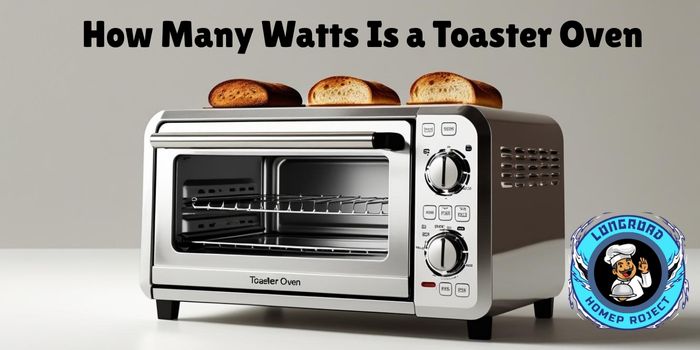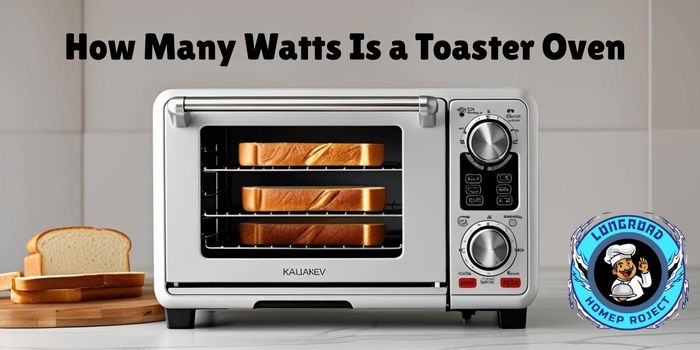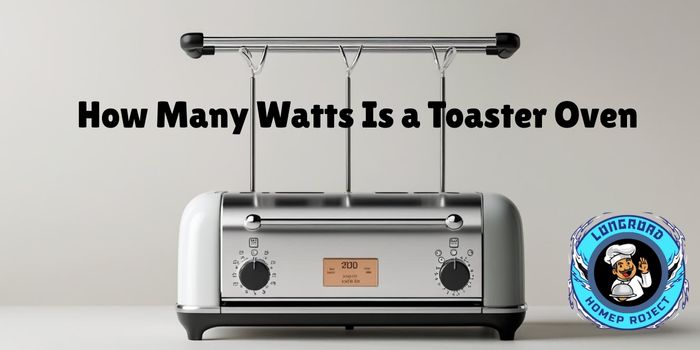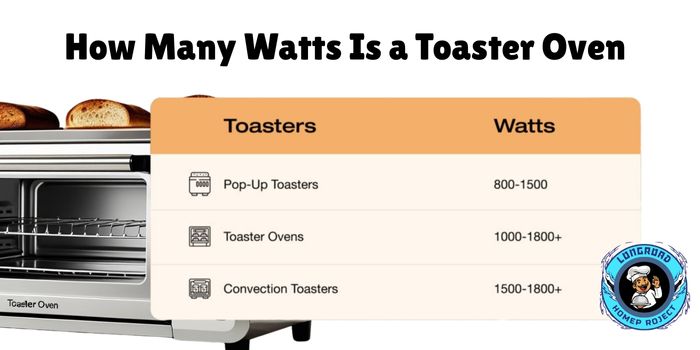As an Amazon Associate I earn from qualifying purchases.
If you’ve ever wondered “How many watts is a toaster oven?”, you’re not alone. For most people, wattage is just another line in the product specs — but in reality, it plays a major role in how your food cooks, how much energy you use, and how safe your kitchen is.
A typical toaster oven runs on 1,000–1,800 watts, depending on its size, heating elements, and special features. The wattage directly affects cooking performance: higher wattage generally means faster preheating, more even baking, and crispier results. On the flip side, higher wattage can draw more electricity, which impacts your monthly utility bills.
In today’s world of rising energy costs and smarter appliances, understanding a toaster oven’s wattage isn’t just for tech enthusiasts — it’s for anyone who wants to cook efficiently, save money, and avoid electrical hazards. Whether you live in a small apartment and need a low wattage toaster oven to avoid tripping a breaker, or you’re a home cook who values speed and precision, wattage is the key spec you should be looking at.
In this guide, you’ll learn:
- The typical wattage range for different types of toaster ovens
- How wattage impacts cooking speed, electricity use, and safety
- How to choose the right wattage for your needs
- Real-life comparisons between toaster ovens, microwaves, and full-sized ovens
- Energy-saving tips to make the most of your appliance
you’ll not only know how many watts is a toaster oven, but you’ll also be able to pick the perfect model for your lifestyle — and use it in the smartest, most cost-effective way possible.
Average Wattage of a Toaster Oven
When it comes to toaster ovens in the USA market, wattage can vary widely depending on the size, features, and design of the appliance. On average, most models fall between 1,000 and 1,800 watts, but there’s more to the story once you break it down by size category.
Typical Wattage Range for Standard Toaster Ovens (USA Market)
In the United States, mid-sized toaster ovens — the type you’ll find in most households — usually operate between 1,300 and 1,500 watts. This is the sweet spot for everyday cooking: fast enough to preheat quickly and bake evenly, but not so high that it draws excessive power.
For reference:
- Entry-level models may use around 1,000–1,200 watts
- Premium models with convection or air-fry features can reach 1,700–1,800 watts
- Specialty or smart toaster ovens (like those with steam-bake or dual-cook modes) may use slightly more power
Compact, Medium, and Large Toaster Ovens
- Compact Toaster Ovens
- Wattage: 1,000–1,200 watts
- Capacity: Usually 2–4 slices of bread or a small 9″ pizza
- Best For: Small kitchens, RVs, dorms, or anyone who cooks in small batches
- Pros: Energy-efficient, heats quickly, minimal counter space required
- Cons: Limited cooking space, may struggle with larger or denser foods
- Medium Toaster Ovens
- Wattage: 1,300–1,500 watts
- Capacity: Fits a 12″ pizza or 6 slices of bread
- Best For: Most households, versatile cooking needs, light baking
- Pros: Balance of cooking speed, capacity, and energy use
- Cons: Requires moderate counter space
- Large Toaster Ovens
- Wattage: 1,600–1,800 watts
- Capacity: Can roast a whole chicken or bake a 13″ pizza
- Best For: Families, frequent entertainers, or baking enthusiasts
- Pros: Handles big portions, multiple cooking modes
- Cons: Higher energy draw, slower to cool, takes more space
Low Wattage Toaster Oven Options & When They’re Ideal
Low wattage toaster ovens — typically under 1,200 watts — are designed for situations where energy efficiency or power limits are a priority. They’re perfect if:
- You live in an RV, camper, or tiny home with limited electrical capacity
- You want to keep your energy bills as low as possible
- You cook mostly small portions and don’t need high heat output
- You’re using multiple appliances at once and need to avoid tripping breakers
These models won’t cook as quickly as higher wattage ovens, but they’re budget-friendly, eco-conscious, and safer for older wiring systems.

How Much Electricity Does a Toaster Oven Use Per Hour?
Knowing how much electricity a toaster oven uses per hour can help you manage your kitchen’s energy consumption and save on utility bills. The calculation is straightforward, and once you understand it, you can compare different appliances to see which is more cost-effective.
Step-by-Step Calculation Method
- Find the toaster oven’s wattage (usually listed on the label or in the manual).
- Convert watts to kilowatt-hours (kWh) — the standard unit your electric company uses for billing.
- Formula: Wattage ÷ 1000 = kWh
- Multiply kWh by your electricity rate (found on your energy bill).
- Formula: kWh × electricity rate = cost per hour
Example: 1000-Watt Toaster Oven
Let’s assume:
- Wattage: 1000 watts
- Electricity rate: $0.15 per kWh (average U.S. residential rate)
Step 1: Convert watts to kilowatt-hours:
1000 ÷ 1000 = 1.0 kWh
Step 2: Multiply by electricity rate:
1.0 × $0.15 = $0.15 per hour
So, running a 1000-watt toaster oven for one hour costs about 15 cents.
Comparison: Toaster Oven vs. Regular Oven
A full-sized electric oven typically uses 2,500–5,000 watts (2.5–5.0 kWh). Using the same $0.15/kWh rate:
- Low end (2,500 watts): 2.5 × $0.15 = $0.38/hour
- High end (5,000 watts): 5.0 × $0.15 = $0.75/hour
This means a toaster oven can use 2–5 times less electricity than a standard oven, making it a more energy-efficient option for small to medium cooking tasks.
Pro Tip: If you only need to bake or reheat small portions, a toaster oven is often the smarter choice — both for your wallet and the environment.
Wattage Comparison – Toaster Oven vs. Other Appliances
When choosing kitchen appliances, wattage is a key factor in energy efficiency, cooking speed, and operating cost. Let’s see how toaster ovens stack up against other common cooking appliances in the USA.
How Many Watts Does a Microwave Oven Use?
Microwave ovens typically use 600–1,200 watts, depending on size and power level.
- Compact models: 600–800 watts (good for reheating small portions)
- Mid-size models: 800–1,000 watts (common in most homes)
- Large or high-powered models: 1,000–1,200 watts (faster cooking, better for large portions)
Microwaves are more energy-efficient for quick heating but can’t match the crispiness or browning a toaster oven provides.
How Many Watts Does an Oven Use?
Conventional Electric Oven
- Wattage range: 2,500–5,000 watts
- Average use: 3,500 watts for baking at 350°F
- High wattage means fast preheating and even baking, but higher electricity costs.
Convection Oven (Full-Sized)
- Wattage range: 2,200–4,000 watts
- Uses a fan to circulate hot air, which can reduce cooking time by about 20%.
- Still much higher wattage than a toaster oven, even with efficiency gains.
How Many Watts Is a Toaster?
2-Slice Toaster
- Wattage: 800–1,000 watts
- Ideal for quick toasting with minimal energy use.
4-Slice Toaster
- Wattage: 1,200–1,800 watts
- Uses more power but toasts more bread in one cycle, which can be more efficient for larger households.
When a Toaster Oven Is More Energy-Efficient
A toaster oven often strikes the perfect balance between speed and energy use — especially for small to medium cooking tasks. It’s more efficient than a full-sized oven for:
- Toasting bread, bagels, or pastries
- Baking cookies or small cakes
- Reheating leftovers
- Cooking frozen snacks like pizza rolls or nuggets
Compared to a microwave, a toaster oven may use slightly more energy, but it delivers better texture and browning — ideal for foods that benefit from dry heat. Compared to a conventional oven, it can use 50–75% less electricity for small meals.
Amps, Voltage, and Safety Considerations
When using a toaster oven, it’s important to understand not only its wattage but also its voltage and amperage. These factors directly affect how the appliance draws power and how safely it operates in your home.
Typical Toaster Oven Voltage in the USA
In the United States, most household toaster ovens are designed for 120 volts, which matches standard wall outlet output. This makes them easy to plug in without special wiring — unlike some high-powered appliances that require a 240V connection.
How to Calculate How Many Amps a Toaster Oven Uses
The amperage (amps) tells you how much electrical current your toaster oven draws while operating. To calculate it, use this formula:
Amps = Watts ÷ Volts
Example:
For a 1,500-watt toaster oven on a 120V outlet:
1,500 ÷ 120 = 12.5 amps
This means the appliance will pull 12.5 amps of current at full power.
Safety Tips for Plugging in High-Wattage Appliances
- Avoid using extension cords for high-wattage appliances — plug directly into a wall outlet.
- Check your circuit rating — most home kitchen circuits are 15 or 20 amps. Using multiple high-powered appliances (like a toaster oven + microwave) on the same circuit can trip breakers.
- Inspect cords and plugs regularly for fraying, heat damage, or loose connections.
- Keep the area clear — ensure there’s enough ventilation around the toaster oven to prevent overheating.
- Don’t overload outlets — plugging too many devices into one outlet increases fire risk.

Choosing the Right Wattage for Your Needs
Picking the right wattage for your toaster oven isn’t just about reading the spec sheet — it’s about matching the appliance to your lifestyle, space, and cooking habits. The right choice can save you money, improve your cooking results, and ensure you’re using your kitchen space efficiently.
Factors to Consider
- Cooking Style
- If you mainly toast bread or reheat leftovers, a low to medium wattage model (1,000–1,300W) will do the job while saving energy.
- If you enjoy baking, roasting, or air-frying, opt for 1,500–1,800W for faster preheating and more even cooking.
- Available Space
- Compact kitchens, RVs, or dorms often have limited counter space and power capacity — making low wattage toaster ovens the smarter choice.
- Larger kitchens can accommodate full-size, higher wattage models without issues.
- Energy Efficiency
- If lowering electricity bills is your top priority, choose a low wattage toaster oven that still meets your cooking needs.
- For frequent cooking, a higher wattage oven might use more electricity per hour but save time, which can offset costs if used efficiently.
Low Wattage Toaster Ovens for RVs, Dorms, or Off-Grid Living
Low wattage models (under 1,200 watts) are ideal when you’re working with:
- Limited electrical capacity (15-amp circuits or generators)
- Portable power setups like solar inverters
- Shared spaces where you can’t draw too much current at once
They may cook slower, but they’re safer for delicate wiring systems and cheaper to run.
High Wattage Models for Faster Cooking and Better Browning
If speed and performance are more important than saving every watt, high wattage toaster ovens (1,500–1,800 watts) are the way to go. They:
- Preheat quickly
- Deliver crispier, evenly browned results
- Handle larger meals without struggling to maintain temperature
My Personal Experience with Toaster Oven Wattage
When I bought my first toaster oven, I didn’t think much about wattage — I just picked the cheapest one I could find. It turned out to be a 1,050-watt compact model, and while it worked fine for toast, it was painfully slow for baking cookies or roasting vegetables.
After a year, I upgraded to a 1,500-watt convection toaster oven. The difference was night and day — faster preheating, crispier pizzas, and perfectly golden brownies. My cooking times dropped, but so did my patience for the old model.
Lesson learned: Lower wattage is great for saving electricity, but if you cook often and want consistent results, the right balance is worth paying for. Today, my 1,500-watt toaster oven feels like the sweet spot — fast enough for weekday meals, efficient enough not to spike my energy bill.

FAQs
How many watts is a toaster oven on average?
✅ Most toaster ovens range from 1,200 to 1,800 watts, depending on size, features, and cooking power. Compact models may be as low as 1,000 watts, while larger convection models can reach 1,800 watts or more.
Does higher wattage mean faster cooking?
✅ Yes — generally, higher wattage means the oven can heat up faster and maintain higher temperatures, leading to quicker cooking times and better browning. However, it also means more electricity consumption per hour.
Can a toaster oven trip my circuit breaker?
✅ It can if it’s high wattage and shares the circuit with other high-power appliances. To prevent tripping, avoid using your toaster oven on the same outlet as microwaves, coffee makers, or space heaters.
Is a low wattage toaster oven better for energy savings?
✅ Yes — a low wattage model uses less electricity per hour. However, cooking may take longer, which can offset some of the savings if you use it frequently for larger meals.
How can I check my toaster oven’s exact wattage?
✅ Look for the appliance label (usually on the back or bottom of the unit) or check the user manual. Many manufacturers also list wattage in the product description online.
Final Thoughts
When it comes to toaster ovens, wattage isn’t just a number — it affects cooking speed, energy use, and even the flavor and texture of your food.
Before buying, check the appliance label to know the exact wattage, then match it to your cooking habits, available space, and budget. If you cook often and want quick results, a higher wattage might be worth it. If you’re in a dorm, RV, or off-grid setup, a low wattage unit can be the smarter choice.
Bottom line? The right wattage = better cooking and smarter energy use.
As an Amazon Associate I earn from qualifying purchases.
